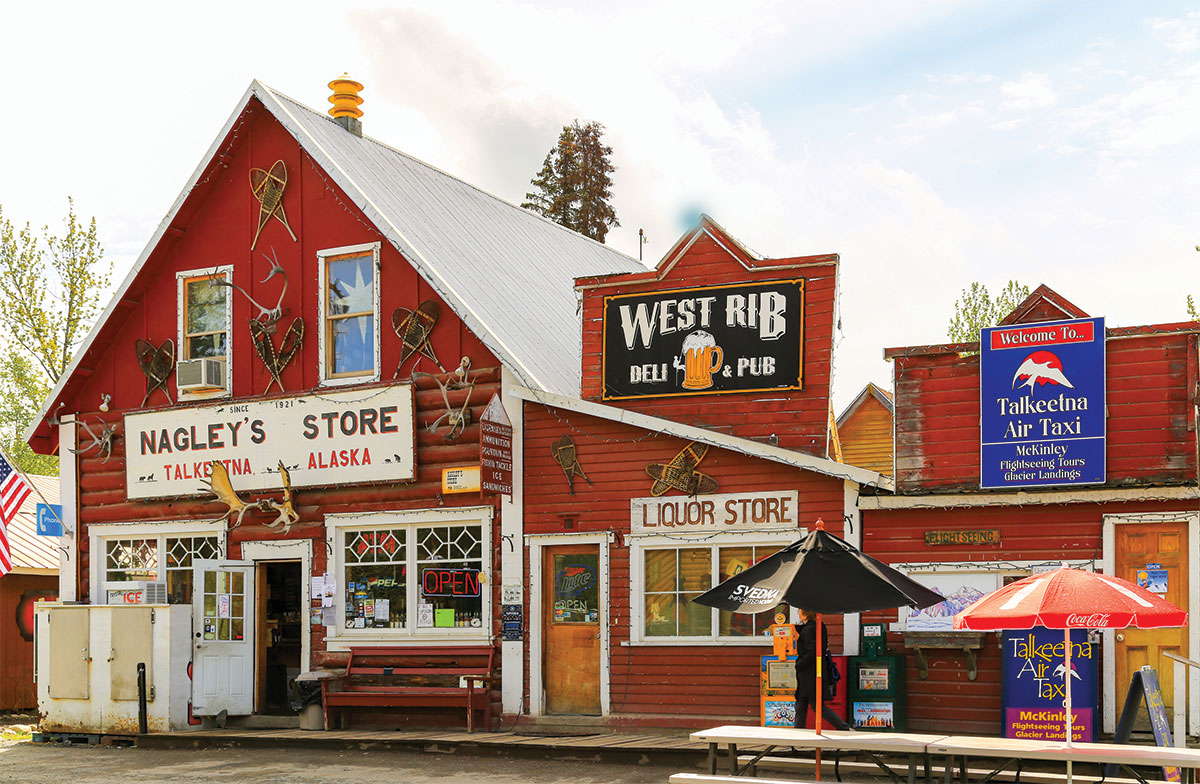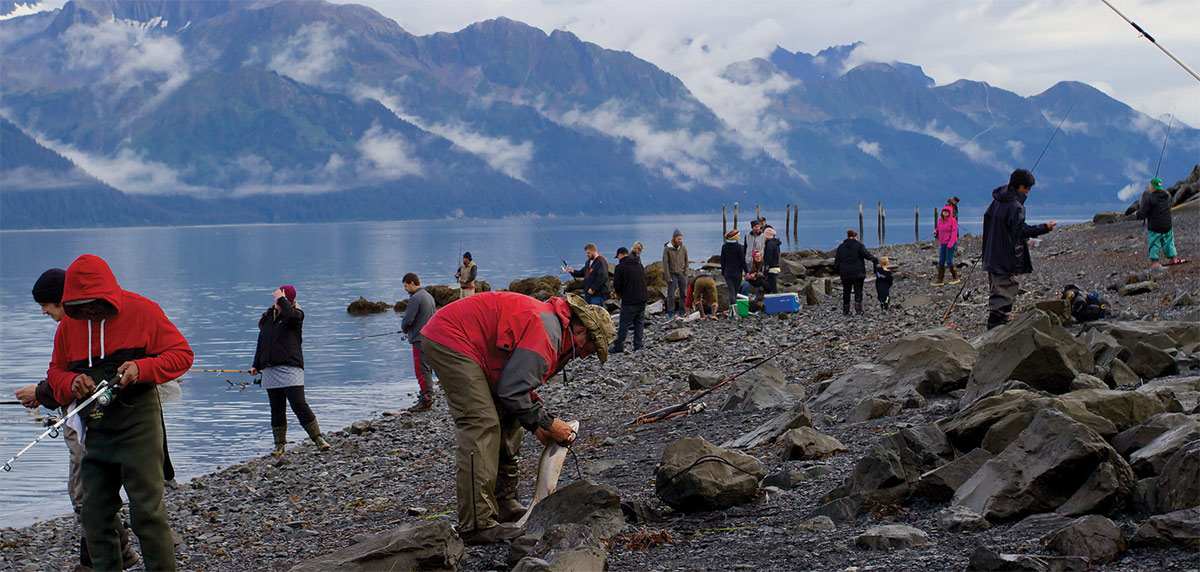but essential transportation
service
ruckers in Alaska joke that the only thing here not delivered by truck is a baby. With only one road connecting Alaska to the Lower 48, most goods—with the notable exception of seafood—end up coming across the docks. And one segment of the transportation industry that is crucial to getting those items from port to door is drayage—a logistical service focused on trucking goods a short distance to retail companies or consolidators.
“Half of that cargo stays in the Anchorage area and the other half gets delivered to destinations outside of Anchorage along the road and rail system within the state,” Port of Alaska Director Stephen Ribuffo says.
Not all that tonnage relies on drayage services, as pipeline-delivered refined petroleum and cement moved by train car are handled differently. Goods moved through drayage services include most items Alaskans expect to see in retail stores, as well as construction materials and other essentials.
As a landlord port, the Port of Alaska is not directly involved in negotiations between shippers, companies removing freight, and companies providing drayage or other transportation solutions. It does lease out property to companies wishing to do business in the area, creating a revenue stream by charging for use of the dock.
“We do not run the dock operations,” Ribuffo says. “People that choose to use the dock run those operations all the way from the stevedoring and longshore work to the arrangements for containers and other cargo to get picked up and delivered to final destinations.”

mixmotive | istock
United Freight & Transport
“Meat, milk, and produce [are] the three things that you have the highest priority on once the ship arrives in Anchorage,” Weaver Brothers Vice President Jimmy Doyle says. “Produce has a real specific shelf life. It’s not like a box of cereal. Produce is only good for, you know, maybe a week at the longest.”
Most produce in Alaska has a noticeably shorter shelf life than fruit and vegetables in the Lower 48 since produce here spends a significant amount of time traveling after being harvested, Doyle says.
“The customers that ordered it, they want to put that on the shelf right away before it gets to where it’s unusable,” Doyle says.
Weaver Brothers oversees distributing groceries throughout portions of the state on behalf of Safeway, Doyle explains.
When weather causes delays, drayage companies often need to shift gears to working at night or putting in overtime to make sure products arrive at their final destination as quickly as possible.
“Weather delays can have a large impact, especially with marine vessels. When a storm delays a ship or barge, the schedule tightens for everyone, and it becomes especially important that drayage companies work efficiently to clear out the backlog of freight once it arrives,” Badger says. “Some customers have time-sensitive or perishable items that have increased urgency. Whenever weather delays do occur, we take care to coordinate with our customers to ensure freight is prioritized… so everyone gets their freight when they need it.”

miracky | iStock
“If you were down in the states, there might be a central distribution warehouse close by where the freight is only a couple hours away,” Doyle says.
In Alaska, the nearest distribution site is four days away by ship in Seattle.
“The two largest carriers of course are Matson and Tote, and we’ve been working with both those carriers since the ‘80s,” Doyle says. “We work on behalf of those two carriers to deliver freight all over town, whether it be Spenard Builders Supply or Costco or Walmart.”
Matson and Tote Maritime ships arrive on Sundays and Tuesdays.
“Every store that you go to in Anchorage is probably getting freight delivered across the port here from either one of those two carriers for the most part,” Doyle says, noting that Weaver Brothers provides the same services for goods that arrive in Kenai or in Fairbanks via the Alaska Railroad.
“Alaska West Express provides most of the drayage for the Alaska Marine Lines barges arriving or departing from Central Alaska,” Badger says.
“Much of the cargo is being unloaded from the barges and delivered to locations throughout Alaska, but cargo is also being taken to the barges for transportation to Dutch Harbor, Naknek, Bethel, Nome, and other locations throughout Western Alaska. Another Lynden company handles most of the drayage at the origin point in Seattle, bringing cargo to the barges destined for Alaska.”
“Predominantly, it’s retail type trade so you’re very, very busy in the summer months,” United Freight & Transport General Manager Frank Monfrey says. “And you’re very busy at this time of the year now, with Thanksgiving and Christmas.”
From February to March, drayage operations are reduced to stay in balance with the seasonal slow-down in retail and construction, Monfrey explains.
“One of the biggest challenges is balancing the number of trucks and drivers with the fluctuating freight demand in Alaska,” Badger says. “Volumes typically increase during the summer as projects and tourism are underway, and it’s important to maintain our workforce of professional drivers to be able to meet those demands as needs change.”
Monfrey creates that balance by running a “very, very lean crew.”
“Maybe sometimes I’m a little slow, but on the other hand I’m never leaving people at home. And that’s a big deal. You know, everybody needs a paycheck so I try to keep them all working,” Monfrey says.
Even with some drivers retiring and with an ongoing pandemic, United Freight & Transport has managed to retain its thirty-eight trucks and drivers.
However, declining retail sales in Alaska continue to have an impact on the drayage sector. The retail industry in the state has faced years of contraction: retail employment was down 2,500 jobs in June compared to last year, a 6.8 percent loss, according to the Alaska Department of Labor and Workforce Development.
Nordstrom in Anchorage closed in 2019 and Pier 1 permanently closed all three of its locations in Alaska in 2020. National sellers exiting the state is part of a steadily declining trend in the retail sector.
“We certainly feel that,” Monfrey says, referring to businesses being shuttered. “It’s had an impact, no question about it—not just this year with this pandemic issue—but it’s had an impact over the last five years.”
Because drayage companies provide services to consolidators, such as Span Alaska and American Fast Freight, they feel the loss even when smaller businesses that wouldn’t be able to take an entire trailer of goods go out of business. And it’s a ripple effect because consolidators, which can provide smaller amounts of goods to retail stores, are also receiving fewer deliveries.
Because consumer goods, such as groceries, make up the bulk of the items being distributed throughout the state, Alaska’s population plays a prominent role in the sector’s expansion or contraction.
Alaska is experiencing the longest stretch of net out-migration since statehood. Starting in 2012, more people were leaving the state than coming to it. However, there was still growth in the population due to there being enough new births to offset deaths and outward migration.
That changed in 2017. The state’s population is now shrinking. And a shrinking population means less demand for retail goods and construction materials.
Anchorage’s population peaked in 2013 at 301,000. By the end of 2023, the population will sink to 286,000, according to Bill Popp, president and CEO of the Anchorage Economic Development Corporation.
Alaska’s population will determine the amount of work available in the sector, confirms Doyle.
“They all positively or negatively impact our work based on which direction they go,” Doyle says.
However Alaska’s other industries impact the future of transportation, drayage is an essential service to Alaskans. Without truckers, store shelves would be empty.
“If you got it from somewhere and you bought it from somewhere, a truck brought it to you,” Monfrey says. “And that’s the bottom line.” ![]()